Garden hedgehogs
Hedgehogs are a gardener’s friend, as they eat beetles, caterpillars, worms and other invertebrates. Here’s what you can do to help encourage hedgehogs into your garden and keep them happy throughout the year.
Did you know as many as 10 different hedgehogs may visit a garden over several nights? This could mean ‘your hedgehog’ is actually a number of different ones visiting at different times!
Make a hedgehog a home
Leave areas of the garden wild, with piles of leaves, logs or compost. These are an attractive nest, as well as a home for the invertebrates that hedgehogs like to eat.
Making an artificial home can be as simple as placing a piece of board against a wall. Or you can buy a purpose-built hedgehog house, or even try to build your own hedgehog house!
Create hedgehog highways
Hedgehogs can travel around a mile every night, so they may need help to get into and out of your garden. Try cutting holes in fences, removing bricks from walls, or digging tunnels under the garden boundary. Hedgehogs can travel through gaps as small as 13x13cm, so these gaps don’t need to be large.
Even better, swapping your garden wall or fencing for native hedgerows provides a route in and out of your garden, as well as shelter for a range of wildlife.
Feeding hedgehogs
Supplementing a hedgehog’s natural diet by leaving out food and fresh water is a great way to encourage local hogs into your garden.
If you’re thinking of feeding your local hogs, remember:
- Leave out foods like tinned dog or cat food and crushed cat or dog biscuits. If the hedgehog is very young – roughly apple-sized – you’ll need to soak the biscuits in water first. You can also get good quality, meaty hedgehog food from wildlife food suppliers.
- Never feed hedgehogs milk or bread – milk can cause diarrhoea and bread isn’t very nutritious.
- Check the food and water bowls each day to top them up with fresh water and food, and remove any food that hasn’t been eaten.
- Always clean the dishes – do this outside (not in the kitchen) every day using hot, soapy water and rinse well. This will help to reduce the risks of spreading disease between different hedgehogs that might eat from the same dish.
Hedgehog-friendly gardening tips
Here’s what you can do to keep your garden hedgehogs safe.
- Cover holes: hedgehogs can easily fall into uncovered drains or holes in your garden. Cover holes or check them every day to make sure no hedgehogs have become trapped.
- Give them a way out of ponds and pools: place bricks or stones at the side of ponds, or create a sloped edge on part of the pond to give hedgehogs a way to climb out if they fall in. Cover swimming pools overnight and when they’re not in use.
- Check for hedgehogs before using strimmers or mowers – particularly under hedges, where they might be resting during the day. If you’re forking over a compost heap, check them for any nesting hogs first.
- Always thoroughly disturb bonfires immediately before you light them, as there could be hedgehogs nesting or hiding inside. Moving the whole bonfire by hand before setting it alight is the best way of ensuring that hedgehogs and other wildlife aren’t sleeping in there.
- Litter is a real hazard to hedgehogs – they can get their heads stuck in tins, plastic bags, binders from drinks cans or discarded yoghurt pots. Make sure you dispose of your rubbish safely and check there’s no litter in your garden.
- Raise any netting: if you have any netting or wire in your garden, make sure it’s at least a foot above ground level, as hedgehogs can easily become tangled up in it. Pack away or roll up fruit nets, tennis and goal nets when they’re not in use. We recommend replacing any netting in your garden with solid metal mesh if possible, as it’s less likely to entangle hedgehogs.
- Don’t close your shed doors if you usually keep them open, as there might be hedgehogs nesting inside. Keep any dangerous chemicals or tools well off the ground. If you need to dismantle your shed, check carefully underneath the floor first for nesting or hibernating hedgehogs.
- Avoid slug pellets and pesticides – these can poison hedgehogs and should only be used as a last resort. Instead, try using one of many natural alternatives, like sprinkling crushed eggshells or coffee grounds around the plants you need to protect. If you have to use pellets, place them under a slate that’s inaccessible to hedgehogs. The outdoor use of slug pellets containing metaldehyde was banned in Great Britain from March 2022.
What to do if you disturb a hedgehog
If the hedgehog is hibernating, gently put it back into its nest, re-cover it with the nest material and leave it alone. If this isn’t possible – for example, because the nesting site has already been destroyed – then place the hedgehog in a part of the garden where it will be safe and sheltered, with as much of the original nest as possible.
If there’s not much natural shelter available, you could use a large box instead, but make sure the hedgehog will be able to get out of the box easily when it next wakes up.
If the hedgehog isn’t hibernating and has young hoglets, re-cover them with the nesting material and leave them alone. If this isn’t possible, please contact us for more advice.
Before you go.
Our priority will always be helping animals in need – from your beloved pets to the wildlife in your garden. To do that, we rely on the kindness of people just like you to help our hard-working team continue the life-saving work that they do 24-hours a day.
From offering wildlife advice just like this to rescuing suffering hedgehogs caught in garden netting – we couldn’t do it without you.
In 2019, we saw a record-breaking flood of hedgehogs coming into our rescue centres, and with each centre costing around £670,000 to run each year, we need your help more than ever.
As a charity, we rely on your generous donations (no matter how small) to help run our centres and support our mission to create a world that’s kinder to all animals. What we’re saying is – every day, our animals rely on the kindness of humans to make a difference.
Your spare change could mean a huge change to an animal in our care. Taking a minute to donate really could mean a lifetime of happiness for an animal in need.
Hedgehogs – Feeding
In the wild, hedgehogs eat a diverse selection of insects as well as some plant material and, very occasionally, small or baby mammals (like pinkie mice). Hedgehogs are nocturnal and usually eat at night.
A pet hedgehog’s diet should mainly consist of high-quality hedgehog food mixed with high-quality, low-fat cat food. The following supplemental foods can be offered in small amounts two to three times a week:
• Gut-loaded insects, such as mealworms and crickets. Gut loading refers to feeding the insects a nutritious diet before feeding them to your hedgehog, so your hedgehog can benefit from the added nutrients.
• Fresh fruits and vegetables, such as apples, pears, bananas, and small sections of cooked carrots
• hard-boiled egg
Check with your veterinarian regarding which vegetables and fruits are recommended for your pet hedgehog. Insects should be purchased from a pet store or raised in the home. Caution should be used in obtaining insects from gardens where insecticides and fertilizers have been used. Earthworms can be a very nutritious treat. Your veterinarian may be able to provide some tips for successfully raising your own insects to offer your hedgehog.
What should I NOT feed my pet hedgehog?
• Avoid lettuce and celery, which are low in nutritional value.
• Do not feed avocados, as they are toxic to your hedgehog.
• Do not feed raw meats or raw eggs to your hedgehog.
• Hedgehogs are not able to digest milk. Consumption of milk and milk-based foods may lead to diarrhea.
• Do not offer nuts, seeds, or hard foods such as raw carrots, as they may get stuck in the roof of the mouth (especially peanut halves).
• Do not offer any “people food” without checking with your veterinarian first.
Hedgehogs have a propensity for obesity if their food intake is not monitored or controlled. Food given in measured proportions and with the appropriate amounts of protein, carbohydrates, fiber, and minerals will help prevent this problem. As with all animals, exercise is extremely important for weight control. Some hedgehogs will run on a wheel, others need a cage large enough to run around in.
Do I need to give my hedgehog vitamins?
Hedgehogs do not require additional vitamins if fed a properly balanced diet.
Hedgehogs do not require treats, although an occasional offering of fresh vegetables, fruits, and grains is acceptable.
What about water?
Water should be available 24 hours a day. Filtered water is preferred. Most owners choose to offer water through a sipper bottle hung in the cage. If using a sipper bottle, ensure that your hedgehog will drink from it. Check the tube whenever you change the water (at least daily) to make sure the sipper tube has not become clogged with food.
Clean all food bowls and water sippers every day with soap and water and rinse well.
What Do Hedgehogs Eat?

Adrienne Kruzer is a veterinary technician with more than 15 years of experience providing healthcare to domestic and exotic animals. She is trained as a Fear Free Certified Professional to prevent and alleviate fear, anxiety, and stress in pets.

Dr. Diehl is a passionate veterinarian pursuing specialty medicine with over 6 years’ experience with exotic pets. She now works with a team of other experienced vets to provide the best advice and care for their clients’ pets.

Jillian Dara is a fact checker for The Spruce Pets, reviewing articles about pet care and pet products for factual accuracy and consistency. She has more than five years of experience in lifestyle editing and media and has been published in a variety of prestigious outlets.
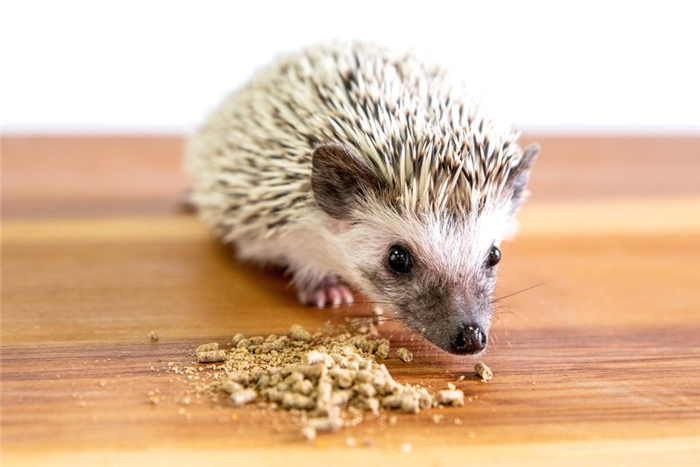
The Spruce / Adrienne Legault
Being insectivores, hedgehogs need nutrients that may not be found in many other pet foods. Historically, cat food was often used to feed these spiky pocket pets, but there are also quality hedgehog foods that provide ideal nutritional components for a hedgehog to eat. Besides pet food, hedgehogs enjoy eating fresh fruits and vegetables. By knowing what a hedgehog should be eating you can make better food decisions for your pet.
General Pet Hedgehog Food Guidelines
Hedgehogs are considered either omnivores or insectivores, depending on the source referenced. If you look at the actual diet of a hedgehog you’ll see that the omnivore description is probably a more accurate one since hedgehogs in the wild will eat a variety of foods, not just insects. Different species of hedgehogs will have slightly varied diets depending on the part of the world they are from, but most pet hedgehogs are African Pygmy hedgehogs so being a hybrid, their diet isn’t the same as a wild hedgehog.
Hedgehogs have the unique ability to digest chitin from insects. Chitin is found in the hard exoskeleton of insects and is primarily a protein source but also provides some fiber. Chitin is a necessary component to a hedgehog’s diet but it isn’t the only thing a hedgehog needs from its food, so various items should be fed in addition to insects.
- Mealworms: Live or freeze-dried mealworms are a good source of chitin for hedgehogs. Live worms also provide a good source of mental stimulation since they move around and make a hedgehog have to work a little harder to catch its food.
- Waxworms: Live waxworms are higher in fat but lower in chitin content than mealworms so these should be saved as treats for hedgehogs.
- Crickets: Also available live or freeze-dried, crickets provide chitin as well as mental stimulation for a hedgehog. As with other insects, gut-loading should be done before feeding crickets to your hedgehog to ensure they are loaded with nutrition.
- Fruits: Dried fruit should be avoided, but a small amount of fresh fruit can be offered to your hedgehog as treats. Apples, bananas, berries, and melons are popular choices among hedgehogs.
- Vegetables: Fresh tomatoes, fresh green beans, and cooked squash are some options that your hedgehog may enjoy. Starchy vegetables, such as corn, potatoes, and carrots should be avoided as well as dried vegetables.
- Cooked meat: High protein, low-fat canned dog or cat food, as well as cooked chicken, can be offered in small amounts to a pet hedgehog.
- Cooked eggs: An occasional bit of scrambled or hard-boiled egg is a nice treat that’s packed with protein for a hedgehog.
- Pinky mice: If you aren’t grossed out by your hedgehog eating a baby mouse, you can offer the occasional pre-killed pinky mouse as a treat.
- Hedgehog or cat kibble: This should be the bulk of your hedgehog’s diet. A high-quality cat or hedgehog kibble should contain at least 30 percent protein and less than 20 percent fat. Hedgehog food is the ideal diet if it meets these nutritional requirements, but few formulated diets are available that don’t include things like raisins and seeds, which are not recommended to feed.
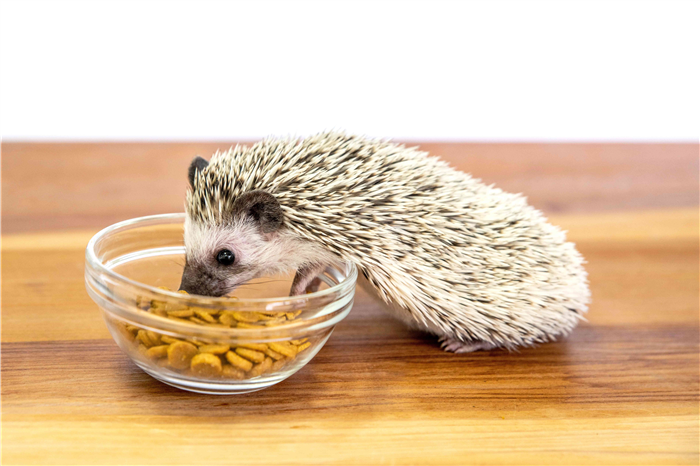
The Spruce / Adrienne Legault
How Much and When to Feed Your Hedgehog
Hedgehogs are prone to obesity, so it is of utmost importance to monitor how much you are feeding it. The hedgehog or cat kibble should make up the majority of the daily diet, and even though a hedgehog is very active at night and burns a lot of energy, you’ll want to control how much kibble it gets.
Each day, one to two tablespoons of kibble should be offered to an adult hedgehog in addition to a teaspoon of fruits and vegetables and some insects. Larger and very active hedgehogs may need more food, but your hedgehog’s weight should be monitored with the use of a baby scale. If there is more than a 10 percent weight gain you should cut back on how much food is offered.
A hedgehog may eat more at night when it is most active and running on its wheel, so don’t worry if you don’t see it eating much during the day. Any uneaten food should be disposed of the next day to avoid spoilage and fresh water should always be available.
The Spruce Pets uses only high-quality sources, including peer-reviewed studies, to support the facts within our articles. Read our editorial process to learn more about how we fact-check and keep our content accurate, reliable, and trustworthy.
What Do Hedgehogs Eat?
When asked to think about animals with great defense, many people will think of a hedgehog. These small, spiky mammals are covered in hundreds of sharp spines made of stiff keratin. That said, they are not to be confused with a porcupine or echidna, which are different species. Hedgehogs belong to the family Erinaceidae, which also consists of moonrats. They get their name from the Middle English words for “hedge” a “hog” or pig, due to their habit of spending time in hedges and their pig-like snout. While they are native to Europe, Asia, and Africa, you can also find them in the wild in New Zealand. You likely have seen a hedgehog before, either online or in a pet store. Perhaps you even know a fair bit about them. That said, do you know the answer to the question, “what do hedgehogs eat?”
In this article, we’ll aim to answer this question about hedgehogs’ dietary habits. First, we’ll examine some different foods that hedgehogs like to eat. Then, we’ll uncover how hedgehogs hunt and forage for food. Next, we’ll compare what hedgehogs eat in the wild versus what they eat as pets. Then, we’ll end with a conversation about baby hedgehogs. So, let’s get this discussion rolling and answer the question, “what do hedgehogs eat?”
What Do Hedgehogs Like to Eat?
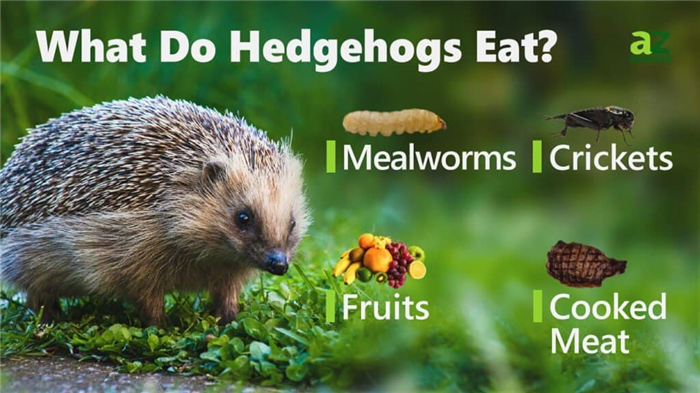
Hedgehogs eat a varied diet including worms, insects, fruits, and small animals.
The type of foods that hedgehogs eat varies depending on their location. For example, a hedgehog in northern Africa will not eat the same food as a hedgehog living in Asia. That said, there are some similarities in the diets of different hedgehog populations. Until recently, hedgehogs used to be considered insectivores, given the insects make up a large part of their diet. Today, it’s more accurate and common to call hedgehogs omnivores, as they eat both plant and animal matter. Hedgehogs are known as greedy eaters and will eat themselves to obesity if given the chance. In the wild, this rarely happens, as they have to forage for food. However, when given the chance, hedgehogs will glad chow down on their favorite treats. In case you were curious, we’ve compiled a list of 10 foods that hedgehogs like to eat. These foods include:
- Insects
- Worms
- Berries
- Fruits
- Vegetables
- Eggs
- Mushrooms
- Roots
- Small animals
- Pet food
How Do Hedgehogs Hunt and Forage for Food?
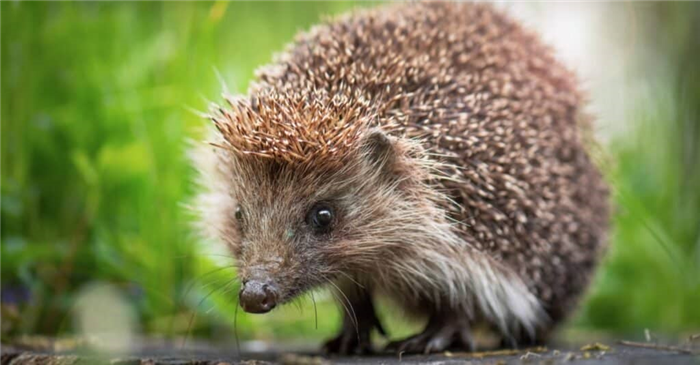
Hedgehogs possess a strong sense of smell and hearing.
Hedgehogs rely on their senses in order to forage for plants and hunt prey. Of their five senses, their sense of smell is likely the one they rely on most to find food. They constantly sniff the air when walking about, and can locate food located more than an inch below ground. Their sense of smell not only helps them to find food but also to locate other hedgehogs and potential threats. Aside from smell, hedgehogs also possess excellent hearing, especially when it comes to detecting high-frequency sounds. On the other hand, a hedgehog’s eyesight is rather poor compared to its hearing and smell. They have poor depth perception and binocular vision, but that’s okay, because they mostly look for food at night in dense underbrush. So, while they may use their vision sparingly to find food, it is by far not their most important sense.
Hedgehogs are nocturnal, which means that they are most active at night. Once the sun goes down, hedgehogs emerge from the burrows to search for food. They tend to spend most of their time foraging in dense hedges, hence their name. This serves a dual purpose, as the hedges are full of food including berries, roots, and insects, and the dense cover also protects them from potential predators. Hedgehogs will root around inside hedges in search of food, and use their paws to dig up plants. If they come across insects or small prey animals, they will simply snatch up the animal with their jaws. Although they’re rather small, hedgehogs can run up to 4 miles per hour for short bursts. This allows them to chase down any fleeing animals and hopefully catch them before they can get away.
What Do Hedgehogs Eat in the Wild?
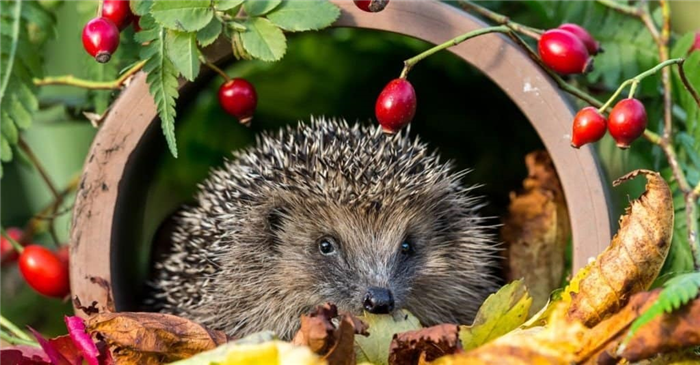
In the wild, hedgehogs eat a variety of plants and small animals including frogs, snakes, and mice.
In the wild, hedgehogs eat a wide variety of plants and animals. Overall though, insects, berries, roots, and small animals make up the bulk of their diet. In particular, hedgehogs love to snack on insects, arthropods, and other small invertebrates. Some of their favorite prey include crickets, grasshoppers, beetles, centipedes, slugs, millipedes, and worms. They will also target and eat small animals such as frogs, snakes, and mice. When available, they may prey on the eggs of birds, particularly ground nesting birds. Plants also make up an important part of a hedgehog’s diet. In particular, they enjoy fruits such as berries and melons. When other foods are in short supply, they will also eat grass stems and roots. Additionally, hedgehogs may also eat carrion if readily available. Finally, hedgehogs that live close to human habitats may raid gardens and snack on the vegetables growing there.
What Do Pet Hedgehogs Eat?
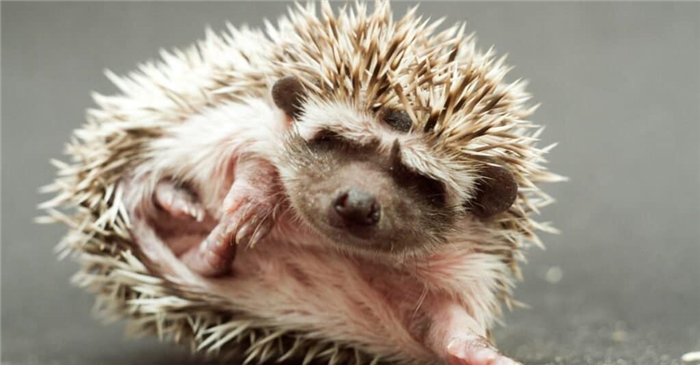
Most people who keep pet hedgehogs opt to feed their pets high-quality hedgehog food.
Despite their spiky appearance, many people decide to raise hedgehogs and keep them as pets. Of the nearly 17 species of hedgehog, the African pygmy hedgehog is the one most commonly kept as a pet due to its small size. If you decide to keep a pet hedgehog, you’ll need to know what to feed your hedgehog to keep it healthy. Many pet hedgehog owners opt to feed their pet high-quality hedgehog food. Additionally, you can supplement your hedgehog’s diet with fresh fruits and vegetables. Safe fruits include bananas, apples, pears, berries, and melons. As for vegetables, go for things like cooked squash, fresh tomatoes, and green beans. You can also feed your hedgehogs insects, mealworms, or even small amounts of cooked meat. Just make sure to keep an eye on its enclosure and to replace food often if it goes uneaten.
There are also certain foods that you should not feed your pet hedgehog. These foods can prove harmful to your pet hedgehog, and should not be part of its diet. These foods include:
- Bread
- Milk
- Avocado
- Raw meat
- Citrus fruit
- Processed foods
- Chocolate
- Raisins
- Onions
What Do Baby Hedgehogs Eat?
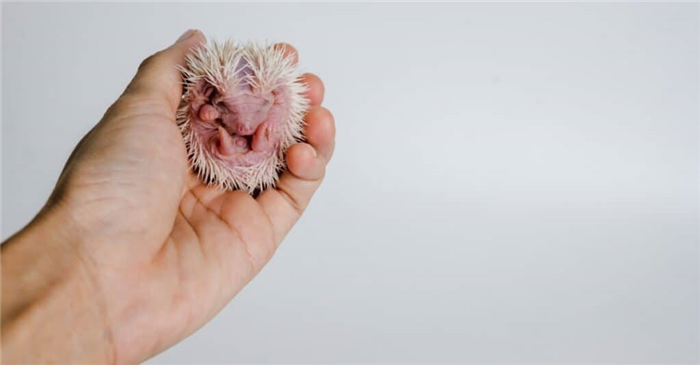
Baby hedgehogs, or hoglets, drink only their mother’s milk for the first 3 or 4 weeks of life.
Also known as hoglets, baby hedgehogs, are typically born during the winter while their mother is hibernating. For the first 3 or 4 weeks of life, the hoglets are completely reliant on their mother. During this time, they subsist solely on their mother’s milk. Once their spines start to grow, they are old enough to leave the nest. At this point, they begin to forage and eat the same foods as adult hedgehogs. Still, they will remain with their mother for several more weeks until they’re ready to venture out on their own. If you’re raising a baby hedgehog, you can feed it tinned or dry pet food. You may need to soak the food in water first in case the food is too dry. Before introducing new food to a hedgehog, make sure to consult with a veterinarian first.
What do wild hedgehogs eat?
Hedgehogs are widely recognised as a potent ally in the garden, but what do they actually eat? What makes up a wild hedgehog’s diet?
Hedgehogs are generalists and feed on a wide range of things. The majority of their diet is made up of invertebrates (or creepy crawlies). We know what they eat from scientific studies that have analysed hedgehog poo or looked in the stomachs of hedgehogs killed on roads.
The most important invertebrates in their diet are worms, beetles, slugs, caterpillars, earwigs and millipedes.
As well as these, they also eat a wide range of other insects. More infrequently, they will take advantage of carrion, frogs, baby rodents, baby birds, birds’ eggs and fallen fruit.
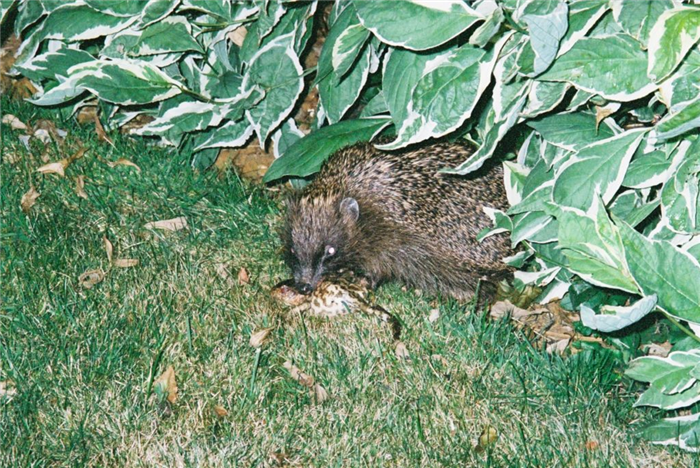
‘Hog eating a frog by Barbara Witowska
When you are putting out food for hedgehogs, you can replicate the hedgehog’s natural diet by providing any combination of meat-based dog and cat food, hedgehog food or cat biscuits.
Studies suggest that hedgehogs only use food in gardens as a supplement to their natural diet and therefore there is no evidence to suggest you are causing them to become dependent on you for food. This means you are free to go on holiday!
